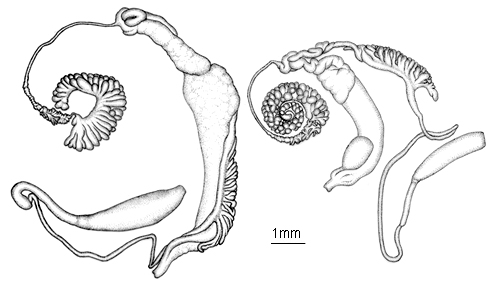Taxonomy
Although morphological measurements have traditionally been used to identify species of Biomphalaria, new molecular tools are proving very useful in uncovering cryptic diversity. Unfortunately, unravelling B. choanomphala's exact status is proving rather more difficult.
Traditional identification methods
Of the 30 or so described species of Biomphalaria, about two-thirds live in the New World (from the southern US in the north down to southern Argentina, and including many Caribbean islands).
Traditionally, these have been described and identified through use of morphological characters, such as:
- shell measurements
- internal organ shape
- size ratios
This works well on these taxa as they derive from an ancient lineage and are relatively well differentiated morphologically. However, it is a less useful identification tool for the 12 more recently evolved African species as in some cases they show overlap of morphological characters.
New tools for identifying species
Recently, molecular tools have been developed which have revolutionised the way in which scientists describe and identify species.
- Enzyme electrophoresis, for example, demonstrated that certain South American species, which looked identical but were behaviourally distinct, were separate species.
- DNA barcoding has similarly assisted in the identification of many African species of Biomphalaria, and resolved redundancies in nomenclature.
Establishing the taxonomic status of B. choanomphala
In the case of B. choanomphala we may need to use the full arsenal of methodologies available in order to establish its taxonomic status.
- Traditionally B. choanomphala was placed as the type species in a species complex which included other small Biomphalaria which inhabited large East African lakes.
- Molecular work has shown that it is actually more closely related to Biomphalaria which look different but which also inhabit Lake Victoria and the Nile - giving the group its name, the Nilotic species complex. This suggests that these snails may have diverged from a common ancestor quite recently.
The morphological similarity seen between B. choanomphala and the other more distantly related Biomphalaria implies that there may be strong natural selection for a particular morphology in a particular habitat.
This has implications for how we balance the information given to us by morphological traits against molecular evidence. It also provides some support for the idea that B. choanomphala is not actually a true species.
-

Lookalikes
Learn more about the Biomphalaria species with which B. choanomphalaria was traditionally grouped, and about the genetic 'lookalike', B. sudanica. Discover the implications for schistosomiasis transmission if B. sudanica and B. choanomphala are not actually true separate species.
-

Evolution
Find out more about the evolution of Biomphalaria snails. As a genus they have a long evolutionary history, though B. choanomphala is thought to be a young species, relatively speaking.
